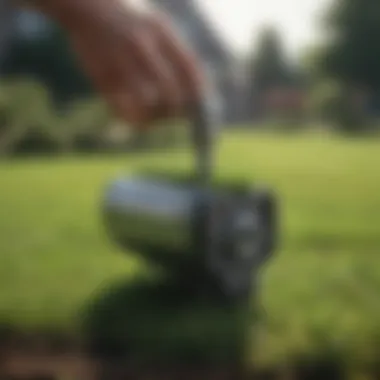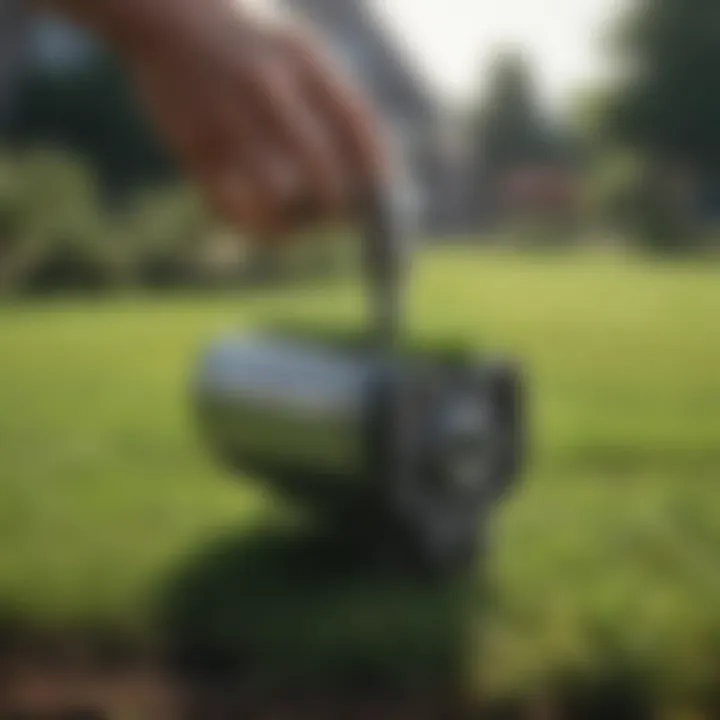Mastering Lawn Aeration in Spring: Essential Insights


Intro
Aerating your lawn is an essential spring task for homeowners aiming to improve grass health and resilience. This process is often misunderstood, but with the right knowledge, it can significantly enhance your lawn's overall quality. Lawn aeration involves perforating the soil with holes to allow air, water, and nutrients to penetrate down to the roots. This not only promotes root growth but also improves the soil structure.
Understanding the timing and techniques of aeration can lead to a thriving lawn. In this article, we will explore the complete guide to aerating your lawn in spring, covering best practices and common myths, to ensure you have the tools to create a lush green space.
Benefits of Aeration
Aerating your lawn offers multiple benefits that help transform it into a vibrant green oasis. Here are some essential points to consider:
- Improved Soil Drainage: Aeration creates pathways for excess water to drain away, reducing the risk of lawn diseases.
- Enhanced Nutrient Absorption: Aeration allows nutrients from fertilizers and organic matter to reach the root zone more effectively.
- Root Expansion: The process encourages deeper root development, making your lawn more resilient against drought and foot traffic.
- Reduction of Thatch: Aeration helps break down thatch buildup, which can suffocate grass roots and impede water absorption.
"Aerating your lawn is like giving it a breath of fresh air."
Common Misconceptions
Many homeowners have misconceptions about aeration that can hinder their lawn care efforts. Clarifying these can help achieve better results:
- Myth: Aeration is only necessary for poor soil.Reality: Even healthy lawns benefit from aeration, especially during the spring when growth resumes.
- Myth: Aeration will kill my lawn.Reality: Proper aeration promotes health; the temporary holes heal, leading to stronger grass.
- Myth: It is too late to aerate in spring.Reality: While early spring is optimal, mid-spring is also suitable, as long as the grass is actively growing.
Techniques for Aeration
To maximize the benefits of aeration, employing effective techniques is critical. Here are the most recommended methods:
- Core Aeration: This method involves removing soil plugs from the ground, allowing air and moisture to reach the root zone more effectively.
- Spike Aeration: Spike aerators create holes by pushing spikes into the ground. This method is less effective than core aeration but can be useful for lawns with minor compaction.
Tools Needed:
- Core aerator
- Spike aerator
- Rake (for post-aeration care)
Maintenance Post-Aeration
After aerating your lawn, follow some simple maintenance steps to ensure optimal results:
- Watering: Ensure the lawn is well-watered immediately after aeration. This aids in healing and helps the grass recover.
- Fertilization: Applying a balanced fertilizer can enhance nutrient availability for grass roots post-aeration.
- Avoid Mowing: Allow your grass to grow a bit longer to recover before mowing.
By grasping the essential techniques and debunking common misconceptions about aeration, homeowners can significantly improve their lawn appearance and health. Embracing these practices in spring will lead to a sturdy, vibrant lawn, ready to thrive through the warmer months.
Understanding Lawn Aeration
Lawn aeration is an essential practice for maintaining a healthy and lush lawn. Understanding this process offers insight into how to improve soil conditions, which is at the core of successful lawn care. The need for aeration arises from several factors, including soil compaction, thatch build-up, and environmental stressors. Proper understanding of aeration helps homeowners recognize when it is appropriate to aerate and the benefits that can be achieved.
Definition and Purpose of Aeration
Aeration is the process of perforating the soil with holes to allow air, water, and nutrients to penetrate down to the roots. The primary purpose of aeration is to relieve soil compaction, improve oxygenation and moisture to the roots, and enhance the overall health of the lawn. Compacted soil inhibits growth by restricting the movement of essential elements that promote healthy grass.
In simple terms, aeration opens the soil, making it easier for grass roots to thrive. This process is particularly vital in spring as the growing season begins, providing the lawn with the best chance for robust growth.
How Aeration Works
Aeration typically involves using specific tools to create holes in the lawn. These holes may vary in size and depth, depending on the method used. The two main types of aeration are core aeration and spike aeration. Core aeration removes small plugs of soil from the lawn, while spike aeration simply creates holes without removing any soil.
Aeration works by increasing airflow within the soil. Mechanically, it allows the soil to breathe, ensuring that grass roots receive necessary oxygen. Additionally, it enables water to penetrate deeper, reducing runoff and encouraging deeper root growth. This increased root development means the grass can access more nutrients and withstand stress better, effectively creating a more resilient lawn.


"Aeration is vital to making your lawn stronger and healthier, especially as it prepares for seasonal changes."
Having a solid grasp of lawn aeration not only fosters better lawn aesthetics but also contributes to long-term ecological balance in your outdoor space. It is crucial for any homeowner or gardening enthusiast to be familiar with this process, ensuring their lawn functions optimally throughout the changing seasons.
Benefits of Aerating in Spring
Aerating your lawn in spring serves essential purposes that directly impact the health and vitality of your grass. Understanding these benefits can help homeowners make informed decisions and take the necessary steps to ensure a thriving lawn. The primary elements to consider include improved air circulation, enhanced nutrient absorption, and increased water penetration.
Improved Air Circulation
Air circulation is vital for a healthy lawn. When soil becomes compacted, the movement of air into the root zone is restricted. This limits the oxygen that roots need to grow. By aerating, you create holes in the soil, allowing air pockets to form. These pockets enable oxygen molecules to reach deeper into the ground, supporting root development.
Additionally, improved circulation can help in reducing thatch, a layer of dead grass and roots that accumulates on the soil surface. An effective aeration process can break down this thatch, encouraging overall grass health.
Enhanced Nutrient Absorption
After aeration, nutrients from fertilizers or organic matter can more readily penetrate the soil. The holes made during aeration serve as entry points for nutrients, allowing them to reach the root system directly. This is especially important in spring when the grass is coming out of dormancy and requires a nutrient boost for vigorous growth.
Furthermore, aeration encourages microbial activity within the soil. Healthy microbial life aids in breaking down organic matter and releasing essential nutrients. With improved nutrient absorption, homeowners can enjoy a vibrant, green lawn that is resilient to pests and diseases.
Increased Water Penetration
Spring often brings rain, but too much water can pool on the surface if the soil is compacted. Aeration addresses this issue effectively. By creating channels in the soil, water can seep down into the ground rather than running off.
This increased penetration helps reduce surface runoff, leading to less erosion and better water retention. As a result, your lawn stays hydrated and has the moisture it needs to thrive. For areas where water tends to collect, aeration can be a critical technique in managing water levels effectively.
The combination of these benefits illustrates the importance of aerating your lawn in spring. It lays the groundwork for a healthier, more resilient lawn, capable of withstanding various environmental challenges.
Optimal Timing for Spring Aeration
Determining the optimal timing for lawn aeration is critical. Aeration done at the right time can lead to significant improvement in grass health. Spring is generally seen as the ideal season for this process, mainly because of the favorable weather conditions and the growth patterns of many grass types.
Correct timing can enhance the effectiveness of aeration. When the soil is warm enough, usually around 50 to 65 degrees Fahrenheit, grass begins its active growth phase. Aerating at this time can rejuvenate the lawn and help it better absorb water and nutrients. Additionally, not all soils are the same. Certain soil types and conditions can respond better to aeration at different points in the spring.
Soil Temperature Considerations
Soil temperature significantly impacts the timing of aeration. It is essential to wait until the soil warms up. If aeration is performed too early when the soil is still cold, it will not yield the desired benefits. Cooler soil temperatures can lead to grass recovery being delayed. As grass roots begin to thrive in warmer soil, air, nutrients, and water can penetrate more effectively.
For optimal results, monitoring soil temperatures can be beneficial. Homeowners can use soil thermometers to measure temperature accurately. This practice helps ensure that aeration occurs at the right moment for maximum impact. Waiting for optimal soil conditions can make the difference between a weak lawn and a vibrant one.
Grass Type and Growth Patterns
Grass type plays a pivotal role in determining when to aerate. Cool-season grasses, like Kentucky bluegrass and fescue, thrive best in cooler spring temperatures. They typically begin growing when temperatures reach around 50 degrees Fahrenheit. Therefore, aerating for these types should coincide with their initial growth periods in the spring.
On the other hand, warm-season grasses, such as Bermuda grass, flourish in warmer conditions. They start to grow when temperatures rise above 65 degrees Fahrenheit. Aerating too early for these grass types could be counterproductive, as it may disrupt their growth cycles.
Recognizing the growth patterns of grass types is essential for establishing a successful lawn aeration schedule. Understanding these nuances will enable homeowners to achieve the best possible results.
The most effective aeration strategy is understanding the unique conditions of your lawn. This includes knowing the soil temperature and grass type.
Aeration Techniques
Understanding the various aeration techniques is central to achieving optimal results in lawn care. Proper aeration addresses issues like compaction and poor water penetration, ultimately leading to a healthier, more vibrant lawn. Each technique has its strengths, and understanding when and how to use them can make a significant difference. In this section, we will explore core aeration versus spike aeration, as well as the distinction between manual and mechanical tools, providing you with a detailed view of your options.


Core Aeration vs. Spike Aeration
Core aeration and spike aeration are two main techniques, each with distinct methods and effects.
Core aeration, also known as plug aeration, involves removing small plugs of soil from your lawn. This method creates voids in the soil, allowing air, water, and nutrients to reach the grassroots more effectively. As a result, the lawn can recover from compaction and improve overall health. Core aeration is particularly advantageous for lawns that experience heavy foot traffic or have clay-heavy soil, as it alleviates these issues.
On the other hand, spike aeration uses a tool with spikes that leave holes in the soil without removing any material. While this method may seem quicker, it is less effective over the long term. Spike aeration can compact the surrounding soil, negating some beneficial effects. Therefore, while it may provide temporary relief, it does not foster the conditions for optimal root development like core aeration does.
In essence, core aeration is generally recommended for effective and long-lasting results bettering soil health.
Manual vs. Mechanical Aeration Tools
When deciding on the tools for aeration, one must consider whether to use manual or mechanical options. Each has its own merits and drawbacks that can influence your choice depending on the size of your lawn and your physical capability.
Manual aeration tools come in various forms, like garden forks or handheld aerators. These tools are often more affordable and give homeowners greater control over their aeration process. However, they require a significant amount of physical effort and time, making them less suitable for larger lawns. Manual tools might be preferable for smaller or patchy areas that specifically need attention.
Mechanical aeration tools, such as powered aerators, can aerate significantly larger areas with less physical effort. These machines can be rented or purchased, and they efficiently execute core aeration. The ease of operation and speed make mechanical tools a popular choice for homeowners with bigger lawns or those looking to aerate multiple times during the season. However, the initial cost and maintenance of these tools should be considered.
In summary, the selection between manual and mechanical tools largely depends on your specific lawn care goals and physical readiness. Understanding these techniques sets the foundation for effectively aerating your lawn this spring.
Preparing for Aeration
Preparing your lawn for aeration is a critical step that can significantly influence the effectiveness of the aeration process. This preparatory phase ensures that the lawn is in optimal condition to gain the maximum benefits of aeration. Without due diligence in this step, the results may not live up to expectations. Key elements to consider include assessing soil conditions and properly mowing and watering your lawn.
Assessing Soil Conditions
Before aerating your lawn, it is essential to assess soil conditions. This involves determining the moisture level and compaction of the soil. If the soil is too dry, the aeration process may compact the soil further instead of alleviating it. On the other hand, overly wet soil can lead to more significant disturbance and damage to your lawn.
To effectively assess soil conditions, you can conduct the following tests:
- Soil Moisture Test: Dig a hole about six inches deep. If the soil sticks to your fingers and forms into a ball, it is too wet for aeration. Ideally, the soil should crumble easily.
- Compaction Test: Press a screwdriver into the ground. If it goes in easily, the soil is loose. If it meets resistance, the soil is likely compacted and may benefit from aeration.
Recognizing these conditions will help in deciding whether it is the right time to aerate.
Mowing and Watering Before Aeration
Proper preparation includes mowing and watering, both of which help set the stage for effective aeration. Mowing should be done one to three days before aeration. This reduces the height of the grass, making it easier for the aeration tools to penetrate the soil. Set your mower to a height of around two to three inches. This is optimal to minimize stress on the grass.
Watering is another crucial element. While you should avoid overwatering, the lawn should be adequately hydrated before aeration. A light watering 24 hours prior to aeration can help to soften the soil, making it easier to aerate.
"Well-prepared lawns benefit more from aeration than those hastily aerated without proper considerations."
Failure to follow these guidelines can lead to suboptimal results. Skipping mow or watering schedules might leave your lawn less capable of absorbing the benefits of aeration.
In summary, taking the time to assess soil conditions and carry out proper lawn maintenance before aeration can improve the overall health and aesthetics of your lawn. By ensuring these steps are followed, homeowners can look forward to a healthier lawn after the aeration process.
Executing the Aeration Process
Executing the aeration process is a critical step in maintaining a healthy lawn. This section will walk you through why proper execution matters, what benefits it entails, and key considerations to keep in mind.
When aeration is done correctly, it leads to a well-oxygenated soil environment, which directly contributes to the overall vitality of your grass. It not only improves the water absorption capacity but also enhances the efficacy of fertilizers. By loosening compacted soil, aeration opens up pathways for roots, allowing for deeper growth and health.
Step-by-Step Aeration Guide


- Prepare the Lawn: Start by mowing the grass to a shorter height, preferably around two to three inches. This helps the aeration tools penetrate the ground effectively.
- Moisten the Soil: Water the lawn the day before you aerate. You want the soil to be moist but not soggy. This will facilitate easier penetration of the aerator.
- Select the Right Tool: Decide between manual or mechanical aeration tools based on the size of your lawn and your physical ability. Mechanical aerators typically cover more ground quickly.
- Areat the Lawn: Follow a systematic pattern across your yard. Aim to make two passes in high traffic areas where the grass appears stressed. Ensure you are removing plugs of soil, ideally around 2 to 4 inches apart.
- Leave the Plugs: After aeration, leave the soil plugs on the surface. They will break down naturally, adding nutrients back to the soil.
Frequency of Aeration
The frequency with which you should aerate can vary based on several factors.
- Soil Type: Heavier soils like clay compact more easily and may require more frequent aeration.
- Grass Type: Lawns with high foot traffic such as those with Kentucky bluegrass may need aeration more often than fine fescue lawns.
- Seasonal Conditions: Generally, aerating once or twice a year is sufficient. Spring is typically an ideal time to aerate as this is when grass begins its active growth phase.
"Aeration is not just a chore; it's an investment in the health of your lawn."
Post-Aeration Lawn Care
Post-aeration lawn care is crucial for maximizing the benefits achieved during the aeration process. After aerating, your lawn is more susceptible to stress, and proper care can ensure that it recovers well and thrives. The aim is to enhance the effects of aeration on root development, moisture retention, and overall grass health. By focusing on watering, fertilization, and avoiding common mistakes, you set the groundwork for a lush and vigorous lawn.
Watering and Fertilization After Aeration
After the aeration process, it is essential to provide adequate watering. The holes left in the soil help water penetrate deeper, but supplemental watering is still important. Aim to water your lawn thoroughly within the first few days after aeration.
- Frequency: Watering should be done more frequently for the first two weeks post-aeration. This helps seeds in the soil activate and promotes deep root growth.
- Duration: Each watering session should last long enough to soak the soil but avoid waterlogging. Typically, 1 to 1.5 inches of water per week is ideal, depending on your local climate.
- Fertilization: Consider applying a slow-release fertilizer about two to four weeks after aeration. This timing allows the grass to absorb nutrients effectively as it recovers and grows. Look for fertilizers high in nitrogen to support leaf growth and root development.
- Organic Options: Organic compost is also a good choice for fertilization. It enhances soil structure and provides beneficial microorganisms.
Common Mistakes to Avoid
Proper care following aeration is important, but many homeowners make common mistakes that can hinder lawn recovery. Awareness of these pitfalls can help ensure successful outcomes.
- Overwatering: It may seem counterintuitive, but too much water can harm your lawn. Always strive for balance; soggy soil can lead to root rot.
- Neglecting Aeration Holes: Some may attempt to fill in the holes. This can block necessary air circulation. Allow them to be.
- Inadequate Fertilization: Skipping fertilization post-aeration can lead to slow recovery. Ensure to provide the nutrients that your grass needs during this crucial period.
- Resuming Normal Lawn Practices Too Soon: Do not jump back into your normal mowing schedule before the grass is ready. Waiting until the lawn has grown back and established a healthy height helps avoid stress on the grass.
"Post-aeration care is as vital as the aeration itself. Neglect can lead to a poor lawn even after good aeration."
Through mindful watering, careful fertilization, and avoiding common mistakes, your lawn can experience the best outcomes after aeration. This approach lays a foundation for a healthier and more vibrant lawn as the season progresses.
Common Myths About Spring Aeration
Aerating your lawn is a practice that can greatly enhance its health and appearance. However, several myths surround lawn aeration that may prevent homeowners from taking full advantage of this beneficial process. Understanding these misconceptions is crucial for making informed decisions regarding lawn care. Addressing these myths helps to clarify the true nature of aeration, its benefits, and when it should be performed.
A significant factor that propels these myths is the varied experiences of individuals. Many homeowners have differing opinions on lawn care based on their personal observations, which can sometimes lead to misunderstandings about the purpose and effectiveness of aeration. By debunking these common misconceptions, homeowners can utilize aeration more effectively in their spring lawn care routines.
Debunking Popular Misconceptions
- Aeration is not needed every year: Some homeowners believe that aeration should only be performed occasionally. This is not necessarily true. Regular aeration in spring helps maintain optimal soil health, especially for lawns that experience heavy foot traffic or compaction. Even if your lawn appears healthy, the underlying soil may still require aeration to promote root growth and nutrient absorption.
- Aeration will make my lawn look worse: Another common myth is that aeration leaves the lawn looking messy and unattractive. While it is true that aeration creates small holes in the ground and brings up soil plugs, this is actually beneficial. Over time, these plugs break down and help to improve the overall nutrient composition of the soil. Ultimately, the aesthetic impact is temporary and the long-term benefits outweigh any initial concerns.
- Aeration is only for sandy or compacted soils: Many people mistakenly believe that only certain soil types benefit from aeration. In reality, all soil types can improve with aeration. Even clay-heavy soils, which often suffer from compaction, benefit from the process. The goal is to create more space for air, water, and nutrients to penetrate the soil regardless of the existing conditions.
- Aeration can be replaced by topdressing: Some individuals think that simply applying a layer of soil or compost (topdressing) negates the need for aeration. While topdressing is beneficial and can improve lawn health, it does not alleviate soil compaction. Aeration provides essential air exchange and increased moisture availability, which topdressing cannot fully achieve on its own. Both practices can complement each other for the best lawn care results.
By clarifying these myths, homeowners can approach their lawn maintenance with a better understanding and greater confidence. It is important to base decisions on research and fact rather than hearsay. For example, resources like Britannica and Wikipedia can provide detailed information on the practices and benefits related to lawn aeration.
Proper aeration not only enhances the health of the lawn but also improves its resilience against environmental stressors, such as drought and heat.
Whether you are new to lawn care or have years of experience, understanding and addressing these myths will lead to better outcomes for your lawn this spring.
Finale: Timing Your Aeration Strategy
Understanding the optimal timing for lawn aeration is essential for achieving the best results in turf health and growth. Seasonal changes significantly influence soil conditions, grass responsiveness, and the success of the aeration process. In spring, as temperatures rise and grass begins to actively grow, aeration becomes a highly effective practice to improve lawn vitality.
Proper timing ensures that the grass can recover swiftly from aeration, making the most of the benefits outlined earlier—improved air circulation, nutrient absorption, and enhanced water penetration. Choosing the right period not only maximizes these benefits but also minimizes stress on the grass, allowing it to thrive throughout the growing season. Furthermore, understanding the specific needs of different grass types during spring can help customize an aeration strategy that suits your lawn's unique requirements.
In summary, the timing of aeration plays a crucial role in enhancing overall lawn health, leading to lush, resilient grass. Failure to aerate at the right moment can detract from the potential advantages, resulting in suboptimal growth and health issues. Hence, evaluating environmental conditions and being mindful of grass growth patterns will set the foundation for a productive and vibrant lawn.
Recap of Key Points
- Aeration is best performed in spring when grass growth is vigorous.
- Soil temperature and grass type greatly affect the effectiveness of the aeration process.
- The advantages of aeration include better air circulation, nutrient absorption, and improved water penetration.
- Timing aeration correctly reduces stress on the grass, boosting recovery potential.
Final Thoughts on Spring Aeration
Implementing a well-timed aeration strategy provides an array of benefits that directly correlate to improved lawn performance. Take the time to analyze your specific lawn's needs, and your efforts will be reflected in the quality of the grass that adorns your landscape.















